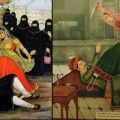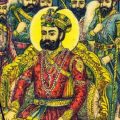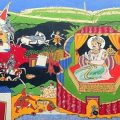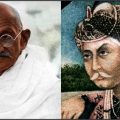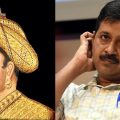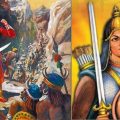Karan Thapar, You Are Wrong about Akbar; Here is How
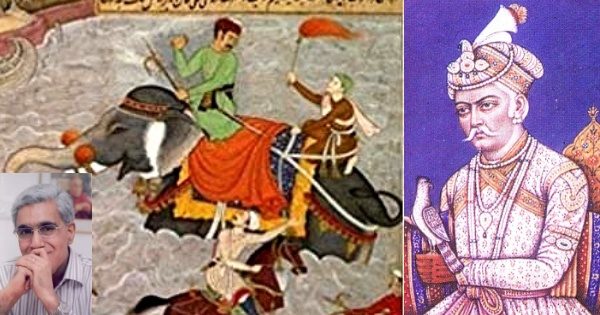
Hindustan Times English Daily newspaper in its Sunday edition of 20th September in an article titled ‘Why Yogi is wrong about the Mughals, writes Karan Thapar’ criticized Yogi Adityanath’s decision to rename Mughal museum in Agra after Shivaji. Thapar used Ira Mukhoty writings to prove that Akbar believed that all religions are either equally true or equally illusory. He quoted Mukhoty where she says that he (Akbar) prayed to the sun, whispered mantras, worshipped fire and kept fasts. His young son Murad was “entrusted to the Jesuits for an education”, taught the sign of the cross and to take the names of Jesus and Mary at the beginning of lessons. Akbar’s Hindu wives were not required to convert. They enjoyed “complete freedom to exercise their own religion”. He abolished the jiziya, “prohibited the slaughter of cows and the eating of their flesh” and was a vegetarian on weekends. He “often wore a dhoti” and appeared in the “diwan-e-aam with a tilak on the forehead and a rakhi on the wrist, tied by a Brahmin, as a blessing”. There were “frescoes painted of Christ, Mary and the Christian saints in the private chambers”. In 1582, he had the Mahabharata translated from Sanskrit to Persian. In later years, he commissioned translations of the Ramayana, Rajatarangini and the story of Nala and Damyanti.
I am surprised reading the article by Thapar. I feel pity that Thaper ignored the writings of Vincent Smith, Jadunath Sarkar, Todd, Elliot and Dawson, Farista etc. Was this an intentional mistake or inherent display of habitual ignorance? Readers are mature enough to decide. I will like to quote Akbar from writings of Vincent Smith. His book Akbar the Great Mogul (1542-1605) was published in 1917. He writes that Akbar was a fanatic of radical belief, merciless to enemy, anti-Hindu in mindset, drunkard and arrogant. Here’s a detailed analysis, proving Karan Thapar wrong.
- Akbar earned title of Ghazi by killing already half dead Hindu King Hemu and celebrated his victory by making tower by heads of slain
Hemu’s artillery, which had been sent on in advance was captured by the vanguard of Akbar’s army in a preliminary engagement. But, even after that loss, the Hindu general still possessed an immense superiority of strength. He relied especially on his 1,500 war elephants, in accordance with ancient Hindu tradition. Each army was drawn up in three divisions. On November 5 Hemu succeeded in throwing both the right and the left wings of his opponents into confusion, and sought to make his victory decisive by bringing all his ‘ mountain-like elephants’ to bear on the centre of the enemy, commanded by Khan Zaman. Probably he would have won but for the accident that he was struck in the eye by an arrow which pierced his brain and rendered him unconscious. An Indian army never could survive the loss of its leader, on whose life its pay depended.
Hemu’s soldiers at once scattered in various directions and made no further attempt at resistance. Hemu’s elephant, which had fled into the jungle, was brought back by Shah Kuli Khan Mahram, and its unconscious rider was placed before the Protector and Akbar, who had ridden up. During the battle the young prince had been kept at a safe distance in the rear, and Bairam Khan had left the conduct of the fight to his lieutenants.
Bairam Khan desired Akbar to earn the title of Ghazi, Executor Slayer of the Infidel, by fleshing his sword on the captive. The boy naturally obeyed his guardian and smote Hemu on the neck with his scimitar. The bystanders also plunged their swords into the bleeding corpse. Hemu’s head was sent to Kabul to be exposed, and his trunk was gibbeted at one of the gates of Delhi. Vigorously pressed, the victors next day, without halting, marched straight to Delhi, which opened its gates to Akbar, who made his entry in state. Agra also passed into his possession. In accordance with the ghastly custom of the times, a tower was built with the heads of the slain. Immense treasures were taken from the family of Hemu and his aged father was executed. (Vincent Smith, p.38-40).
- Akbar married Bairam Khan’s wife who was his protector and raised him from childhood
In 1557-8, the Bairam ladies of the royal family arrived safely from Kabul and Khan rejoined Akbar at Mankot. The army marched to Lahore, halting on the way at Jalandhar, where Bairam Khan married Salima Begam, an accomplished young lady, the daughter of Humayun’s sister, and consequently a grand-daughter of Babur and cousin of Akbar. After the fall of Bairam Khan, Akbar married her himself. She lived until 1612, and always ranked as one of the most important ladies of the court. (Vincent Smith, p. 40).
- Merciful Akbar?
Akbar’s annexations were the result of ordinary kingly ambition supported by adequate power. The attack, devoid of moral justification, on the excellent government of Rani Durgavati was made on the principle which determined the subsequent annexations of Kashmir, Ahmadnagar, and other kingdoms. Akbar felt no scruples about initiating a war, and once he had begun a quarrel he hit hard and without mercy. His better nature made itself felt after victory had been secured. Until then his proceedings were much the same as those of other able, ambitious, and ruthless kings.
Rani Durgavati made a gallant defence, but many of her fate soldiers, apparently terrified by the might of the invader, deserted and left her to fight the enemy with inadequate forces. Her final stand was made between Garha and Mandla, now in the Jabalpur District. Mounted on a mighty elephant, she led her men with the utmost bravery until disabled by two wounds from arrows. Choosing death rather than dishonor, she stabbed herself to the heart, so that her end was as noble and devoted as her life had been useful’ (Vincent Smith, p.71).
- Killing of Kafirs nothing more than a play
An extraordinary incident which occurred in April while the royal camp was at Thanesar, the famous Hindu place of pilgrimage to the north of Delhi, throws light upon Akbar’s character. The sanyasis, or fakirs, who assembled at the holy tank, were divided into two parties, which Abul Fazl calls Kurs and Puris. The leader of the latter complained to the king that the Kurs had unjustly occupied the accustomed sitting-place of the Puris, who were thus debarred from collecting the pilgrims’ alms. Neither party would listen to friendly counsel. Both factions begged permission that the dispute might be decided by mortal combat. The desired leave having been granted, the hostile crowds drew up in line, and the fight began with swords, one man on each side advancing in braggart fashion and starting the fray. Swords were discarded for bows and arrows, and these again for stones.
Akbar, seeing that the Puris were outnumbered, gave the signal to some of his more savage followers to help the weaker party. The reinforcement enabled the Puris to drive the Kurs into headlong flight. The vanquished were pursued and a number of the wretches sent to annihilation. The dead are said to have been about twenty. The chronicler unctuously adds that ‘the holy heart, which is the colourist of destiny’s worship, was highly delighted with this sport’. The other historians tell us that the numbers originally engaged were two or three hundred on one side and five hundred on the other, so that with the reinforcement the total came to about a thousand. The author of the Tabakat agrees with Abul Fazl that ‘the Emperor greatly enjoyed the sight’.
It is disappointing to find that a man like Akbar could encourage such sanguinary sport and even want only sacrifice of the lives of his own soldiers who had no interest in the quarrel. (Vincent Smith, p. 78-79).
- Massacres by Akbar at Chittodgarh
The jauhar sacrifice completed before the final capture of the Chittodgarh fortress was on a large scale, although far smaller massacres than on previous occasions, if the traditional numbers can and be believed. The fires were kindled in three distinct places, belonging respectively to members of the Sisodia, Rathod and Chauhan clans. Nine queens, five princesses, their daughters, as well as two infant sons, and all the chieftains’ families who happened not to be away on their estates perished either in the flames or in the assault. Abul Fazl estimates that three hundred women were burnt. During the course of the following morning, when Akbar made his entry, eight thousand Rajputs, vowed to death, sold their lives as dearly as possible and perished to a man.
Akbar, exasperated by the obstinate resistance offered to his arms, treated the garrison and town with merciless severity. The eight thousand Rajput soldiers who formed the regular garrison having been zealously helped during the siege by 40,000 peasants, the emperor ordered a general massacre, which resulted in the death of 30,000. Many, however, were spared and made prisoners.
It is said that Akbar estimated the total of the Rajput dead by collecting and weighing the ‘Brahmanical cords’ (janeo or zandr), which it is the privilege and obligation of high caste men to wear. The recorded amount was 74 mans of about eight pounds each. (Vincent Smith, p. 89-91).
- Akbar, a drunken freak
A queer story related by Abul Fazl describes an incident which happened at or near Surat. One night, we are told, there was a select drinking-party, and the talk turned upon the disregard for life shown by the heroes of Hindostan. It was said that two Rajput rivals would run from opposite sides against the points of a double-headed spear, or two spears, held by third parties, so that the points would transfix both of the rivals and come out at their backs. Akbar, who could not pretend to have a rival, announced, to the horror of his fellow revellers, that he would fight his sword. He fixed the hilt into the wall, and was about to transfix himself by rushing against the point, when Raja Man Singh ‘with the foot of fidelity’ kicked down the sword, and in doing so cut his sovereign’s hand. Akbar promptly knocked down Man Singh and squeezed him hard. Saijdd Muzaffar, one of the merry party, was obliged to go so far as to twist Akbar’s injured finger, in order to make him loosen his hold on the throat of Man Singh, whom he would have choked in his rage. The opportune wrench opened Akbar’s wound, but that soon healed. Akbar must have been shockingly drunk. He appears to have had the good sense not to resent the rough measures by which his friends saved him from himself, and it is wonderful that two historians should have had the candour to record the scandalous affair.
Although the uncritical panegyrists of Akbar make no mention of his drunken bouts, and his published sayings include phrases condemnatory of excess in wine, it is certain that for many years he kept up the family tradition and often drank more than he could carry. (Vincent Smith, p.89-91)
- Inhuman torture by Akbar
On the arrival of the emperor at his capital, Husain Kuli Khan (Khan Jahan) waited on him with his prisoners. The eyes of Masud Husain Mirza had been sewn up, and Akbar was credited with kindness because he directed them to be opened. The other prisoners, nearly three hundred in number, met with little mercy. They were brought before Akbar with the skins of asses, hogs, and dogs drawn over their faces. Some of them were executed with various ingenious tortures, and some were released. It is disgusting to find a man like Akbar sanctioning such barbarities. His philosophy sometimes failed to curb the tendency to cruelty which he inherited from his Tartar ancestors. The severities practiced did not finally extirpate the Mirza trouble, which soon broke out again in Gujarat. (Vincent Smith, p. 116).
- Always it was Gain of Islam
Badaoni, the historian, who was then one of Akbar’s court chaplains or Imams, had begged leave of absence to join in the holy war, in which he took part as a follower of Asaf Khan. His description of the battle is the most detailed and accurate extant. He enjoyed himself, in spite of the scorching heat and air like a furnace which made men’s brains boil in their skulls. At one stage in the fierce struggle, Badaoni asked Asaf Khan how he could distinguish between the friendly and the enemy Rajputs, and was assured in reply that he could not do wrong if he shot, as sportsmen say, ‘into the brown’, because, as the commander cynically Observed, ‘On whichever side they may be killed, it will be a gain to Islam’. Badaoni gladly took the advice, and was soothed by an inward conviction that he had attained the reward due to one who fights against infidels. He also had the pleasure of observing that the son of Jaimall, the hero of Chitor went to hell and that there was much other ‘good riddance of bad rubbish’. (Vincent Smith, p. 152-153)
There are many such instances from life history of Akbar to prove that Akbar was a diehard fanatic. Even if Pseudo-intellectuals like Karan Thapar wants to project Akbar as peace loving and popular king, they will always miserably fail.
Featured image courtesy: Google, Wikimedia, and cover image part from Ira Mukhoty’s book Akbar: The Great Mughal.
Disclaimer: The views expressed here are solely of the author. My India My Glory does not assume any responsibility for the validity or information shared in this article by the author.

